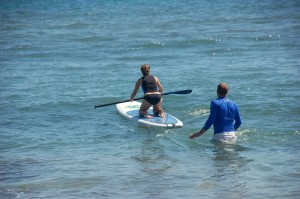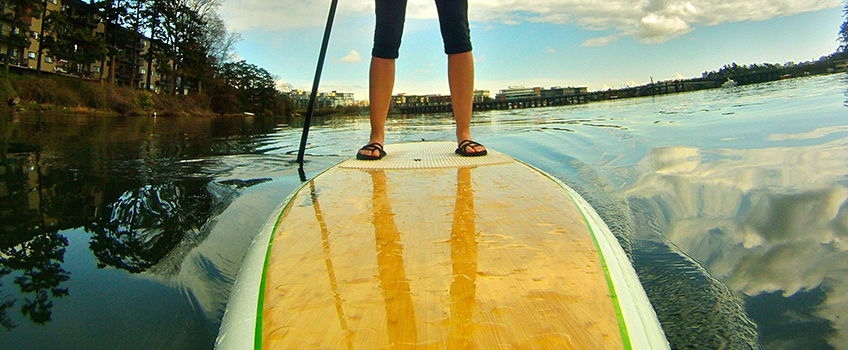Welcome to part 3 of A Beginner’s Guide to Stand Up Paddle Boarding.
If you’ve just got here and haven’t read the first two parts, feel free to jump there first:
A Beginner’s Guide to Stand Up Paddle Boarding – Part 1: How to Choose the Right Board
A Beginner’s Guide to Stand Up Paddle Boarding – Part 2: What Else You’ll Need at the Beginning
A Beginner’s Guide to Stand Up Paddle Boarding – Part 4: Paddling Techniques
Now onto part 3!
So you’ve got the SUP board sitting on the beach, at the edge of the water. You’ve now either carried your own board from your car or house to the beach, or you’re at an area that let you rent the board. Either way, you’re all ready to get on the water and feel the waves beneath your feet.
But then the question comes up in your mind: How do I do this?
No worries. Using a SUP is one of the easiest board sports on the water.
I’d suggest for your first attempt at paddle boarding to choose a calm day with very little waves and wind. Those are a hindrance for anyone just starting out and trying to find your balance. Once you get your balance, then you can take on some waves. Also look for an area with few people around (give yourself a 20 foot radius), as they can cause waves and can potentially be an obstacle in the way when falling.
You should also be ready to fall off the board at the start. Unless you have the balance of a Olympic gymnast, this will most likely happen. Falling off the board is actually good at the beginning because it helps teach you how to get back on in deeper water. You should aim to fall off the board to the sides, and try not to save yourself by falling on the board. This may both hurt the board and hurt yourself, so if you begin to fall, go sideways. With a ankle leash, the board will stay with you, so no worries if the fall is more of a jump away from the board.
So now you’re on the beach. Let’s go! First, we want to make sure all the gear is ready. Your life vest or other PFD is on and tight. All your other gear is stored safely on the beach or under the luggage straps on the board. Your paddle’s length is set (on average this should be about 6-12 inches taller than you), its extended to the position you need and locked (in case you had to extend it). You’ll also want to hook the ankle strap on now if you have one.
Next we’re going to pick up the board and put the board into the water. Now as a HUGE precautionary note, make sure you put the board far enough in the water to ensure the fin on the bottom isn’t hitting a rock or digging into the sand. You don’t want to jump on the board with the fin hitting the ground and snapping off.
Set the board into water, about knee deep to start. I’d suggest picking a beach that is mostly sandy in the water, with very few rocks/reef because if you fall, you want a soft landing. Place the paddle on the board, towards the front, perpendicular to the board. You can hold it here with one hand. Now, facing forward, you put one knee on the far side of the board, about half way between the handle hole and far side of the board. The handle hole will be your focal point for your balance as its at the center of your board. Now using your hands as balance, get your other knee up on the other side of the handle, straddling it at a comfortable width. Note how spread apart your knees are and adjust until you find a good balance with your hands (and paddle) off the board.
 Sometimes if you’re not the most balanced person, it could be wise to get a friend to help keep the board stable, and from moving while you begin. Just make sure they know to watch for you falling (and especially the paddle!).
Sometimes if you’re not the most balanced person, it could be wise to get a friend to help keep the board stable, and from moving while you begin. Just make sure they know to watch for you falling (and especially the paddle!).
Starting to paddle on your knees will help keep you stable to begin with. The paddle will be too long at this point, but that’s ok. You can try paddling a bit and feeling the water and your balance from here.
When you’re ready to stand, put the padding across the board again, just in front of your knees, with both hands open over top of it, to keep your balance(and keep the paddle from rolling off). Then bring one foot up to where your knee was (aim for your toes to be at the same level as the handle). Steady yourself if you feel a little off balance. Next, bring your other foot to where your knee was, which should be about shoulder-width apart. You should basically be squatting with both feet and both hands on the board. Now slowly extend your knees to standing position, bringing the paddle up with you. If needed, keep your back bent while rising, to keep your center of gravity lower.
You shouldn’t be locking your knees straight here, but rather keep them with the slightest of bends, to maintain stability. Fully stand up, using the paddle for balance (as a tight rope walker would). Use your bent knees as shock absorbers for slight waves or being off balance. The key is to keep your core/upper body as stable as possible, using your legs to offset any rise or lowering of the board.
When you’re stable, carefully inch your feet forward, back or sideways to find the best balance for you. Don’t fully take your foot off the board, or you’ll unbalance the board too much and tip over. Some people are more comfortable with a wider stance, while others prefer feet closer to the middle. Test out each until you find the best width that keeps you stable.
Now put the paddle in the water and slowly paddle the SUP. The paddle in the water will help stabilize you as well. Keep in mind, while paddling, not to watch the paddle, but rather try to keep your eyes up on the horizon to keep yourself stable.
Once you’re more stable with paddling, you can look around, admire the ocean/lake/river floor below you, watch for waves, view the scenery, etc. For now, just keep your eyes forward, and slowly paddle to test your balance. We’ll discuss paddle technique in future posts, but for now just paddle as you can.
And once you’re up, congratulate yourself, because you’re now SUP-ping!!



Leave a Reply